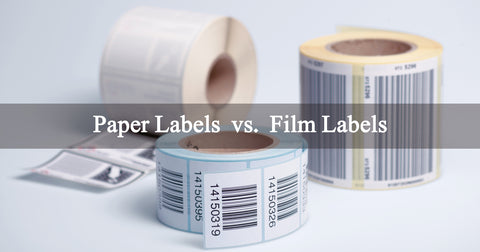
Know your Label materials: Film Labels versus Paper Labels
|
|
Time to read 2 min

Written by: Kelly Chen
|
|
Time to read 2 min
If the customers don’t like the label, they tend to reject the product. The label quality, material, style, shape, colors and other characteristics as just as important as the text. As a business owner, it’s essential to know when to use paper labels and when to use film labels.
For example, film paper, offers great flexibility and durability, but the print won’t be as sharp compared to paper labels. Buyers do read product labels. If the text is hardly visible, it could turn them off.
Eager to find out more? Here is what you should know about film versus paper labels so you can make a reasonable decision and increase sales.
Table of Content
Paper is one of the most common materials on the market. It comes in varied types and textures, from gloss and semi-gloss paper to metalized and textured options. Any of these can be customized by your needs.
Both paper and film are suitable as a facestock - the top layer that you print on. Paper is the most common type of facestock and can be made from pulp or natural wood.
Paper has an excellent “printability”. This means that it allows for brighter, sharper, and higher quality printing. However, film labels lack the prinability of paper. The latter holds ink extremely well as can withstand high-heat printing. Due to the natural texture of paper, image quality and clarity can be better in paper labels than film labels.
One of the biggest advantages of paper labels is their versatility. While paper labels are typically white, you can find paper labels available in a wide range of fun and vibrant colors, from pastels to bright shades. Moreover, paper labels can also be used to give a handcrafted, weathered, or vintage look to most products. Varying the color for the paper adds new aesthetic qualities and opens up avenues for artistic expression, and eye-catching design.
Are there any drawbacks?
Like everything else, paper labels have their drawbacks. Paper labels are generally used for indoor applications. Because they offer a relatively short lifespan. Paper is its lack of resistance to conditions such as water, light, time or tearing. It’s more likely to yellow and fade and break down when exposed to sunlight.
Despite its drawbacks, paper is one of the most economical substrate options.
By now, you should have a better idea of the differences between paper and film labels. The latter offer great flexibility and durability, making them suitable for outdoor applications or moisture-rich environments. Some film materials feature “weatherproof” qualities and can stand up to various conditions such as water, heat/cold, chemicals, oil, fading and even tearing. Because of this, they are a best choice for heavier duty uses. On the negative side, they don’t offer the same print sharpness as paper labels. This can be a major drawback if you want your products to stand out. Another drawback is that film substrate are costlier to produce than its paper counterpart.
Both paper and film labels have advantages of drawbacks. Paper is more affordable and versatile, offering a vintage look.
Film labels last longer but come with a higher price tag and fail to provide the same print sharpness as paper facestocks. Plus, they are more durable and long-lasting to the environment.
In short, there’s a material for every project. Consider the pros and cons of film and paper labels to choose the right option for your specific application. For more information and help deciding whether paper or film is right for your label, you can reach out to our customer service representatives: cs@betckey.com.
If you want to buy thermal labels or sticker paper, you can check out more on our store
Brother DK-1241 Compatible Shipping Labels 4" x 6"
Barcode Shipping & Multipurpose Labels 4" x 2"
Always consistent quality with these labels and with Betckey in general. Fast shipping; great prices when ordering in bulk and lots of choices for different colors in addition to the white ones.
These labels are every bit as good as the (Preferred) brand, at a lot less of a price.
Excellent service. I am very happy with the product. Recceived the labels next business day.
First time using a thermal printer and was amazed at how easy this was to set up. Very compact and print quality is great. Printer was shipped out very quickly and arrived in two days of ordering. This company seems to go the extra mile to satisfy their customers.
The value for money on these is insane. 100% recommended
I've been purchasing these for years - over a decade, I think - and each and every time I make a purchase, I remind myself to do a review this time. THIS is the time! They are absolutely perfect. They fit and perform in my DYMO 4XL LabelWriter exactly as they are supposed to. They have the exact right amount of adhesion. I couldn't be more happy with these tiny labels!




